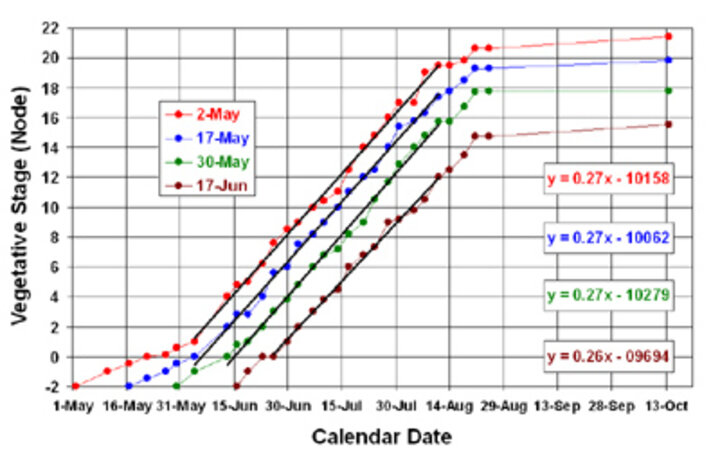May 4, 2007
Soybean planting has been delayed in some areas of the state due to wet fields and delayed corn planting. We're rerunning the following story on a UNL research project that looked at the effect of late planting dates on soybean yields.
In soybeans, the number of nodes per plant is a critical yield component, since a node is where flowers and pods are produced. To optimize yields, producers should use management practices that allow for the most nodes to develop while not eliminating any potential node development. The best way to do this is with earlier planting.
The importance of node number was demonstrated in a two-year soybean trial funded by the Nebraska Soybean Board. The planting dates were early, mid, and late May and mid-June in 2003 (see Figure 1) and 2004 (similar results, so 2004 data not shown). The number of nodes on soybean main stems for each planting date was recorded twice a week.
Note that the May 1 planted soybeans took longer to germinate and emerge than the May 15 planted soybeans (see Figure 1). Still, the May 1 planted seedlings started outputting a new node almost every four days well before the May 15 planted seedlings did. Also note that the node production trend lines for each planting date are parallel to each other. This means that late-planted soybean plants cannot produce nodes faster than the early planted soybean plants, and thus cannot "catch up" with the early-planted soybeans. All the soybeans in this research produced one new node every four days, no matter the planting date or cultivar. Results in 2004 were similar.
So what about the impact of planting date on seed yield, given that early planting generates more nodes? In 2003, each day planting was delayed after May 1 resulted in a 0.24 bu/ac yield loss, which translates into one bu/ac yield loss for every four days of planting delay. In 2004, each day of planting delay resulted in a 0.64 bu/ac yield loss. This means 2.6 bu/ac yield was lost with every four days of planting delay after May 1.
This research indicates that soybean producers need to plant early to optimize yield potential, but how early? Two factors should be considered:
-
- The risk of late spring freeze that could destroy early planted seedlings. Keep in mind that late April or early May planted soybean seed does not germinate or emerge as fast as late May planted seed because of the cooler soil temperatures. Germination and emergence may take as long as 14 days, so one rule of thumb is to plant no earlier than 14 days before the historical last spring freeze date in your area (i.e., if that date happens to be May 11, don't plant before April 28 to keep your freeze risk low).
To learn more about the timing and probability of late spring freezes, visit the High Plains Regional Climate Center Web site.(Under Climate Products, click on Historical; choose Nebraska from the drop-down box; select the weather station in your area, then select Spring Freeze Probabilities.)
- Abnormal early flowering in early June, which can lead to short unproductive plants. Abnormal early flowering occurs in years with very warm April temperatures, which speed up emergence and the production of unifoliolate leaves. These leaves sense the short photoperiods of late April and the result is an early conversion of vegetative meristems to reproductive meristems. Developing seeds compete with the cells in the stem apex for photosynthate to the extent that stem elongation may cease. This phenomenon was common in 2004 for those producers planting in early April and then because of warm temperatures seeing seedling emergence well before the end of April.
Keep in mind that early-planted soybeans will be slow to germinate and emerge, and once emerged, will also be attractive to over-wintered bean leaf beetles, which can infect soybeans with bean pod mottle virus. Consider treating your seed with a systemic insecticide and use only high quality seed. Ask your seed dealer to provide cold germination test results in addition to the standard warm germination percentage. Since a late April or early May planting usually involves cold soil temperatures that will greatly slow germination and emergence, a seed-applied fungicide may be a good management option.
(Data used in this story is from Master's Thesis research of Angela Bastidas.)
James E. Specht
Professor of Agronomy
Angela Bastidas
Graduate Research Assistant

